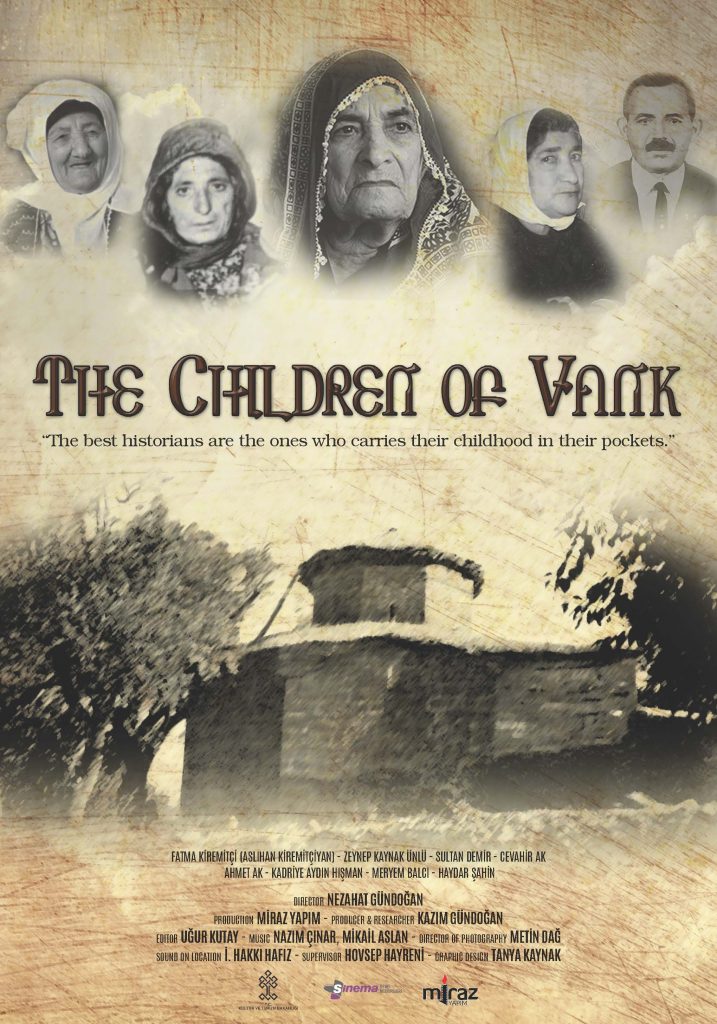Special for the Armenian Weekly
NEW YORK (A.W.)—In recent years, there has been a growing awareness of, and interest in, exhuming the stories of Islamized Armenians in Turkey. Though filmmaker Nezahat Gündoğan did not initially seek to portray the account of this “hidden” community, after researching the project for four years, she determined that it absolutely had to be told. Her documentary, The Children of Vank (“Vank’in Çocuklari”), weaves together the stories of an Islamized Armenian family who survived both the 1915 Armenian Genocide and the Dersim Massacre of 1938, unraveling the truth behind their lost Armenian identity.
On April 26, Columbia University screened the film to a diverse audience. A discussion then followed with Gündoğan, Oral Historian Eylem Delikanli, and demography and Armenian village history expert George Aghjayan. Dr. Khatchig Mouradian moderated the discussion, which centered on the importance of unearthing the stories of Islamized Armenians in Turkey and accepting their experiences as intangible contributions to our collective and ethnographic history. “I want to welcome [Islamized Armenians] into the family and remove them from the column of the dead,” said an impassioned Aghjayan. The event was sponsored by the Armenian Center at Columbia University, Research Institute on Turkey, the National Association for Armenian Studies and Research (NAASR)/Calouste Gulbenkian Foundation Lecture Series on Contemporary Armenian Issues.
The Children of Vank adds to the discourse of Islamized Armenians in an understated way. After conducting exhaustive research on the subject matter, the filmmaker assumed the backdrop to the stories of these individuals. Though the film’s structure is mainly in interview format, the viewer never sees or hears the interviewer. Each “set” of family members speak separately to the camera about their broken memories, with only their first names listed against a black screen. Eventually, all of the stories come together in this arduous campaign to unmask the truth.
The film begins with Zeynep, a schoolteacher who lives in Izmir. About a decade ago, she inadvertently discovered that her mother was born in Dersim as an Armenian, and, following the 1938 Massacre, was forcibly adopted, her name changed from Aslıhan Kiremitçiyan to Fatma Kiremitçi, and lived the rest of her life as a Sunni Turk. This leads Zeynep on a journey to find her lost relatives—namely her mother’s sister. The film then traces the stories of several other members of the family as they discover their Armenianness and connection to their lost relatives and lands.
After losing contact for over 70 years, the family attempts to find each other and reconnect, despite living in different parts of the world, ascribing to differing ethno-religious identities, and even after their immediate relatives have passed. They speak about their lost Armenian identities, raising themes of ethno-religious belonging, the fragmentation and politicization of memory, and the painful legacy of genocide that continues to haunt Islamized Armenians today.
Prior to the Dersim Massacres, the Surb Garabed Vank (or St. Garabed Monastery) served the village’s Armenian inhabitants for centuries. The 9th century church was the only Christian place of faith in Dersim that was not destroyed during the Armenian Genocide. Sadly, this fortuitous fate was short lived, as bombings in 1937-8 completely destroyed the once-proud structure, and its last monk was exiled; most of the Armenian and Alevi communities of Dersim were either killed or uprooted. There were, however, instances of Armenians surviving—mostly by acquiring a new identity as a Kurd or Turk. The ‘new’ family represented in this documentary—Fatma, Zeynep, Sultan, Cevahir, Ahmet, Kadriye, Meryem, and Haydar—stand as a testament to the latter group.
Gündoğan calls her film ‘the children of the monastery’ because St. Garabed played such an immense, foundational role in the lives of pre-genocide Dersim Armenians that it served as an allegorical parent for Armenians of the village. The rediscovery and ‘homecoming’ of the Islamized Armenians of Dersim is very much tied to the historical legacy of the vank and what it has bequeathed generations of Armenians.
At The Children of Vank’s premiere in Istanbul in February, Gündoğan stated, “It is hard to be a Kurd, an Alevi, a woman, a homosexual, a child—to be the ‘other’ –in these lands…But being an Armenian is even more difficult. Armenians are seen as ‘the other of the other.’” Much of the same sentiments were echoed at the Columbia University screening.
The current demographic makeup of Dersim (now called Tunceli) is almost exclusively Kurdish, but some experts estimate that well over half of the local population today has Armenian roots. Mihran Prgiç Gültekin, the head of the Union of Dersim Armenians, estimates that about 75% of the village’s population are “converted Armenians.” Just four years ago, Aram Ateşyan, the acting Armenian Patriarch of Constantinople, claimed that 90 percent of Tunceli’s population is of Armenian origin.
The Children of Vank is part of a larger effort that Gündoğan and her husband Kazim (who was also a researcher for the film) made to uncover the horrific truth of the Dersim Massacre, which includes two groundbreaking documentaries, Two Locks of Hair: The Missing Girls of Dersim (2010) and Unburied in the Past (2013), and a book, The Missing Girls of Dersim (2012).
The documentary was also screened in Yerevan as part of the Golden Apricot Film Festival last year, and will be screened in different cities in the coming months. The trailer can be viewed below:
The screening of the documentary and the panel discussion that followed it concluded a series of successful lectures and discussions organized by the Armenian Center at Columbia University during the Spring 2017 Semester. Other events included a lecture by Dr. Khatchig Mouradian—who served as visiting professor at Columbia in the spring—on the Armenians in China, and a conversation between artists Eric Nazarian and Eric Bogosian moderated by Nicole Vartanian.

